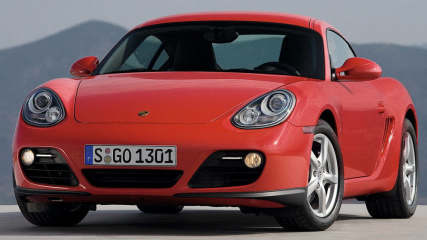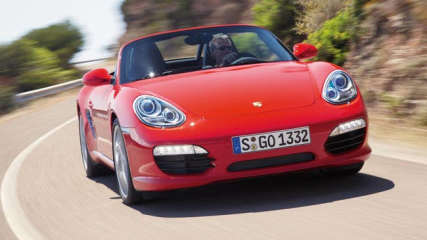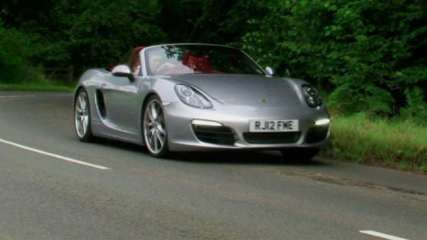Porsche Boxster 2012 Review
By Paul Gover · 28 Mar 2012
I will never look at a Porsche Boxster the same way again. A two-day dash to France, headlined by a sprint over some classic Monte Carlo Rally roads, has won me over to the baby of the Porsche family.It's just had a road-up renewal and, even without the essential final prices, I'm convinced it's much more like a 911 than earlier members of the Boxster brigade. The styling is more aggressive, the cabin is bigger and much better, and the Boxster S - with optional sports exhaust - is a hoot to drive in any condition.Porsche also says the car is more economical and the folding roof only takes nine seconds to do its work. Since 1996 it's been easy for me to giggle at the baby of the Porsche family, dismissing it as a softie and a hairdresser's car.When my friend Wazza arrived in one I knew it had to belong to his girlfriend. He is a V8 Supercar driver, after all. But the third-generation Boxster, which is the first major spin-off from the latest and lovely 991-series Porsche 911, is a major success. It is finally all grown up and a great drive.VALUEIt's impossible to rate the return on the new Boxster, because no-one at Porsche Cars Australia is talking about the showroom stickers for the first local deliveries in July. But European customers are paying about three per cent more and that points to around $110,000 for the basic Boxster and $135,00 for the Boxster S.That should be a good deal with so much new stuff, from the hugely improved chassis and new cabin to comfier new seats and engines that burn less fuel. It will still be too much for Mazda MX-5 buyers in the $50,000 range, but a realistic step up from an Audi TT and a better choice than the latest BMW Z4 or a Benz SLK.TECHNOLOGYThe Boxster takes around 50 per cent of its parts from the 911 as it has in the past, but this time that means great things like the latest electric power steering, direct fuel injection for the downsized 2.7 and unchanged 3.4-litre engines, wider tracks, a longer wheelbase and even a cabin with a dash that's more upscale than before.There is also a seven-speed PDK double-clutch automatic, with six speeds still for the manual unlike the 911, a body that's both lighter and stronger, a roof that's claimed to make major cuts to cabin noise - although there is no tonneau cover - bigger standard wheels, an electric parking brake, more equipment choices and more.The engine tweaks give a power and torque bonus for the 2.7 while taking economy as low as 8.2 litres/100km, while the 3.4 Boxster S now has 232 kiloWatts, a 0-100km time as swift as 4.8 seconds, a top speed of 279km/h and economy of 8.8 litres/100km. The cars also come, predictably, with a stop-start system to save fuel at the lights.DESIGNThe new Boxster picks up a range of family links, from the latest 911 to the classic Carrera GT and even the upcoming 918 supercar. The one thing it does not have, thankfully, is the soft and gentle look of pervious models. The new car is edgy, chunkier and with a side profile that says speed - not comfort.Inside, the overall effect is more solid and upscale, from the shape of the seats to the dashboard layout, feel of the switches and even the position of the centre console. For the first time, I can sit in the passenger seat and really stretch my legs.The folding roof is fully automatic for the first time, it works very quickly, and even if Porsche says it works up to 55km/h I know it will actually do a quick umbrella job in a shower at closer to 70. Porsche says the drag co-efficient is down a little to 0.30 in the base car, with better aerodynamic grip and cooling.SAFETYBigger brakes and better tyres start the work, and the basic structure is also more rigid with predictable rollover protection, with front and side airbags.Porsche has always put avoiding a crash first and that means things like a torque-vectoring differential as part of the stability control system, and the electro-mechanical steering, work with the driver at all times. We're unlikely to see an ANCAP rating for the Boxster, but it's safe to assume a five-star overall package for the car.DRIVINGThe Boxster has always been a good drive, but this new car is great. You can fling it down the toughest road you can find, and we found a few in France, and it never comes up short. The Boxster S is plain wonderful, especially with the optional PDK gearbox and a sports exhaust that serves up the sort of soundtrack that previously only came with cars like tweaked Subaru STi turbos.You can glide around town enjoying the extra comfort and quietness in the cabin, then really run riot and take full advantage of the extra stability in the chassis, the extra punch from the 3.4, more power from the brakes and a steering system that - like the new 911 - gives better control without worrying feedback.It's a car with depths you can just keep tapping, without worrying or getting flustered. And there is the efficiency payback of the improved economy. The basic 2.7 feels is a little hollow in the engine room, at least by comparison, but the basic package works just as well and people who really don't want - or need - the serious edge in the new S will find the plain Boxster is just fine.The new car is so solid I almost forget that it's a full-on convertible until the first sprinkles of rain. Then it's quick and easy to go for security, and a reminder that it's a no-compromise droptop. The real surprise, and it's something I discovered in the original Porsche Cayman, is that the new Boxster is a car you would genuinely choose to buy ahead of a 911.It's a sweeter, more accessible package and not just a cut-price alternative if you cannot stretch to $229,000 for a starting-price Carrera. The Boxster S is a true four-star car, and even the base car gets three and-a-half from me. That makes it a true breakthrough and a car that has forced me to re-think my position. I like it a lot and I didn't giggle once.VERDICTFinally, a Boxster that's more than just the cheaper choice for people who really crave a 911.PORSCHE BOXSTERPrice: From $110,000 (Estimate)Warranty: 3 years/100,000kmResale: 66 per centService Interval: 15,000km or 12 monthsSafety Equipment: front-side airbags, ABS, EBD, EBA, TC.Crash rating: not availableEngines: 195kW/280Nm 2.7-litre; 232kW/360Nm 3.4-litre BODY 2-door, 2 seats.Dimensions: 4374mm(L); 1801mm(W); 1282mm(H); 2475mm(WB) WEIGHT from 1310 kgTransmission: 6-speed manual, 7-speed PDK; rear-wheel-driveEconomy: from 8.2 L/100km;192g/km CO2







